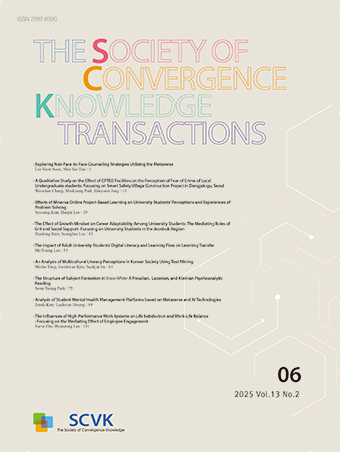Research Article
Abstract
References
Information
최근 DLS와 DLF 사태로 인해 DLS와 DLF의 기초자산인 환율에 대한 관심이 높아졌다. 특히 한국 경제 구조상 환율이라는 용어 자체에 대한 관심이 증폭되어 가고 있고, 환율의 상*하락 폭에 따른 리스크에 민감한 사회적 분위기로 인해 이에 대한 대처와 예측이 필요하다. 따라서 본 연구는 ECOS에서 제공된 비정상 시계열 자료인 2007년부터 2018년까지 총 144개월의 월별 대미 달러 원/달러 환율을 이용하여 2019년 환율 값을 예측해보고자 진행되었다. 추세가 없는 환율을 고려하여 비정상 시계열 데이터의 예측이 가능한 Box-Jenkins의 ARIMA (Autoregressive Integrated Moving Average) 모형을 이용하였다. 모형 선택을 위해 모형을 식별, 추정, 진단하여 최종 모형을 선택 후 예측 값을 제시하였다. 그리고 추정된 예측 모형의 예측 정확도를 비교하기 위하여 이중지수 평활법을 이용하였다. 이때, 이중지수 평활법의 가중치를 구하는 방법은 관련 통계량 값이 가장 적게 나온 가중치의 값을 적용하여 비교 분석하였다.
The recent DLS and DLF developments have raised interest in exchange rates, the underlying assets of DLS and DLF. In particular, interest in the term exchange rate itself is growing in the structure of the Korean economy. Due to the risk-sensitive social atmosphere caused by the rise and fall of the exchange rate, we need to deal with it and make predictions. Therefore, this study was conducted to predict the exchange rate for 2019 using the monthly Won/Dollar exchange rate for a total of 144 months from 2007 to 2018, which is non-stationary time series data provided by ECOS. Using the ARIMA model of Box-Jenkins, which can predict non-stationary time series data, considering the exchange rate without trend. To select the model, the model was identified, estimated, and diagnosed, and the final model was selected and the prediction was given. In addition, Quardratic exponential smoothing method was used to compare the predicted accuracy of the estimated predictive model. At this time, the method for obtaining the weight of the secondary index smoothing method was compared and analyzed by applying the weight value with the least relevant statistic value.
- Bomi Kim, Jeahee Kim “Time Series Models for Daily Exchange Rate Data”, 응용통계연구, 제26권 제1호, pp. 1-14, 2013.10.5351/KJAS.2013.26.1.001
- 서종덕 “데이터 마이닝 기법을 이용한 환율예측 – GARCH와 결합된 랜덤 포레스트 모형”, 산업경제연연구, 제29권 제5호, pp. 1607-1628, 2016.
- 김창범 “환율변동성의 예측과 장기기억”, 산업경제연구, 제26권 제1호, pp. 49-66, 2013.
- 정동빈 “시계열분석방법을 사용한 환율동향의 탐색 및 예측”, 경영교육저널, 제6권, pp. 143-151, 2005.
- 이상래 “환율예측모형의 비교연구”, 한국과학기술원, 2005.
- 오문석, 이상근 “환율결정모형의 원/달러 환율 예측력 비교, 경영학연구, 제 29권 제4호, pp. 711-722, 2000.
- 민경창, 하헌구 “SARIMA 모형을 이용한 우리나라 항만 컨테이너 물동량 예측”, 대한교통학회지, 제32권 제6호, pp. 600-614, 2014.10.7470/jkst.2014.32.6.600
- 안창호, “SAS/ETS를 이용한 전산금융분석“, 도서출판 탐진, 2014.
- Akaike, H, “Information theory and an extension of the maximum likelihood principle”, Proceedings of the 2nd International Symposium Information theory, pp. 267-281, Akademiai Kiado, Budapest, 1973.
- Liung, W. K. and Box, G. E. P, “On a measure of lack of fit in time series model”, Biometrika, pp. 297-303, 1978.10.1093/biomet/65.2.297
- 손은호, 박덕병 “계절 아리마 모형을 이용한 관광객 예측”, 농촌지도와 개발, 제19권 제2호, pp. 301-320, 2012.10.12653/jecd.2012.19.2.301
- Publisher :The Society of Convergence Knowledge
- Publisher(Ko) :융복합지식학회
- Journal Title :The Society of Convergence Knowledge Transactions
- Journal Title(Ko) :융복합지식학회논문지
- Volume : 7
- No :4
- Pages :69-78
- DOI :https://doi.org/10.22716/sckt.2019.7.4.052




 The Society of Convergence Knowledge Transactions
The Society of Convergence Knowledge Transactions







